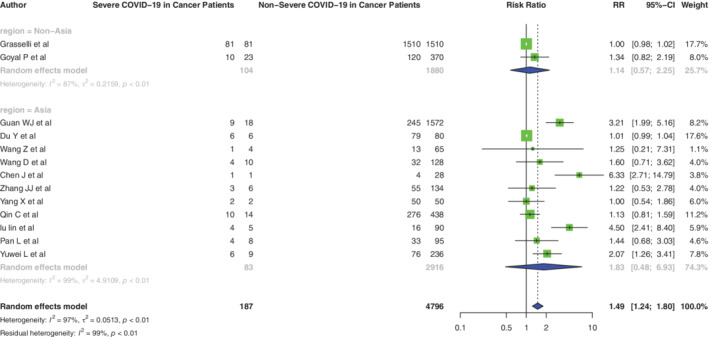Editor
The COVID-19 pandemic has created an international crisis. Healthcare systems are crumbling under these unprecedented pressures and elective treatment pathways, including cancer care services have been severely affected1.
In a recent survey 59 per cent of surgeons from 20 European countries stated that the pandemic is having a strong or very strong impact on treatment of their cancer patients2.
Our aim with this review is to summarize relevant studies published on cancer patients in COVID-19 patient cohorts to help surgeons with data-driven decision making.
We searched for studies containing information on cancer and the severity of COVID-19 infection according to our protocol (see supplement file for research protocol).
13 articles were identified meeting the qualifying criteria for quantitative synthesis (The references of the studies are available in the electronic supplement).
The pooled prevalence of cancer cases in the COVID-19 cohort was 4·2% [95% CI: 3·05-5·74] Significant heterogeneity among studies was seen for cancer (p < 0·001; I2 = 72·5%).
The pooled prevalence of cancer cases in the severe outcome subgroup of COVID-19 cases was 5·3% [95% CI: 4·53-6·24] versus 2·6% [95% CI: 1·52-4·38] in the non-severe outcome group.
Cancer prevalence in cohorts from Asia was 3·9% [95% CI: 2·66-5·72] and studies from Italy and USA showed a pooled prevalence of 5·1 [95% CI: 4·06-6·29] and 5·9% [95% CI: 3·75-8·65] respectively (p = 0·18).
At this moment there is a lack of data on COVID-19 and gastrointestinal cancer especially immediately after surgical resection or chemoradiotherapy.
Higher prevalence rates have been reported in a number of studies with more severe outcomes in the cancer group3,4. Our own analysis revealed 4·2% pooled prevalence of cancer cases in the COVID-19 cohort. We have also been able to demonstrate a 3·9% prevalence of cancer in Asian and 5·24% prevalence in Non-Asian populations.
The pooled prevalence of cancer cases in the severe outcome subgroup of COVID-19 cases was 5·3% [95% CI: 4·5-6·2] versus 2·6% [95% CI: 1·5-4·4] in the non-severe outcome group, similar to published findings from Liang et al.5
Cancer appeared to be a risk factor for severe COVID-19 infection. (RR 1·4894 [1·2357-1·7952] p = 0·0001) (Fig. 1).
Fig. 1.

Risk Ratio for Severe COVID-19 Cases in patients with Cancer
Our data is supporting the current approach taken by many countries where elective cancer surgery is deferred to a later date with the intention of surgery to be done once the pandemic is over. Such an approach is taken in order to preserve intensive care resources and to protect the individual cancer patients from severe adverse outcomes.
This rapid review has demonstrated that cancer patients have a higher likelihood of developing severe COVID-19 pneumonia and they also have a higher mortality rate than non-cancer patients.
Should the pandemic take longer or if we encounter a re-emergence of the virus our cancer strategy will have to change, and cancer treatment pathways will have to adapt to the pandemic.
Supplementary Material
Appendix S1. Supporting Information
References
- 1. Tuech JJ, Gangloff A, Di Fiore F, Michel P, Brigand C, Slim Ket al. . Strategy for the practice of digestive and oncological surgery during the Covid-19 epidemic. J Visc Surg 2020; 157: S7–S12. [DOI] [PMC free article] [PubMed] [Google Scholar]
- 2. Nevermann NF, Hillebrandt KH, Knitter S, Ritschl PV, Krenzien F, Benzing Cet al. . COVID-19 pandemic: implications on the surgical treatment of gastrointestinal and hepatopancreatobiliary tumours in Europe. Br J Surg 2020; 10.1002/bjs.11751 [Epub ahead of print]. [DOI] [PMC free article] [PubMed] [Google Scholar]
- 3. Wang D, Hu B, Hu C, Zhu F, Liu X, Zhang Jet al. . Clinical Characteristics of 138 Hospitalized Patients With 2019 Novel Coronavirus-Infected Pneumonia in Wuhan, China. JAMA 2020; 323: 1061–1069. [DOI] [PMC free article] [PubMed] [Google Scholar]
- 4. Epidemiology Group of Emergency Response Mechanism of New Coronavirus Pneumonia . Analysis of Epidemiological Characteristics of New Coronavirus Pneumonia. 10.3760/cma.j.issn.0254-6450.2020.02.003 [DOI]
- 5. Liang W, Guan W, Chen R, Wang W, Li J, Xu Ket al. . Cancer patients in SARS-CoV-2 infection: a nationwide analysis in China. Lancet Oncol 2020; 21: 335–337. [DOI] [PMC free article] [PubMed] [Google Scholar]
Associated Data
This section collects any data citations, data availability statements, or supplementary materials included in this article.
Supplementary Materials
Appendix S1. Supporting Information


